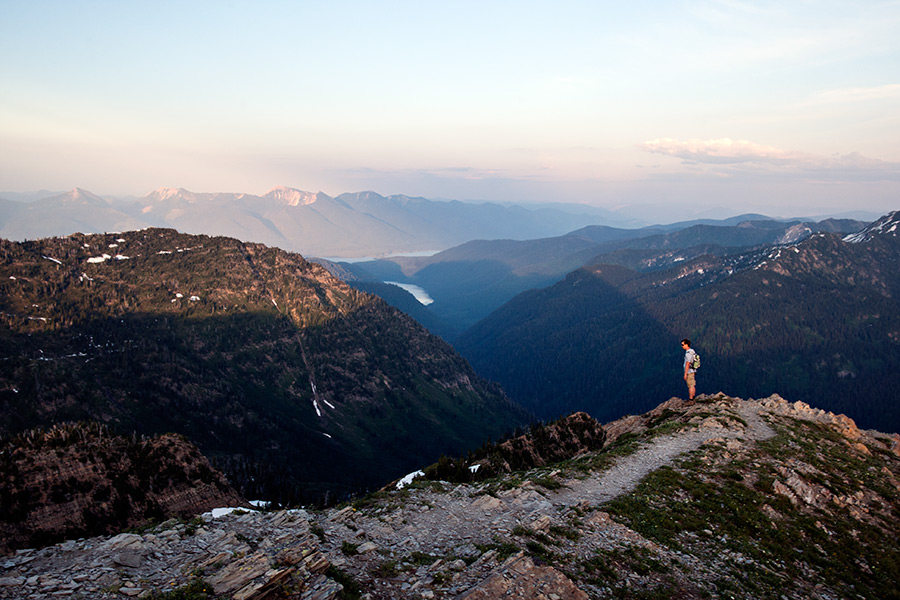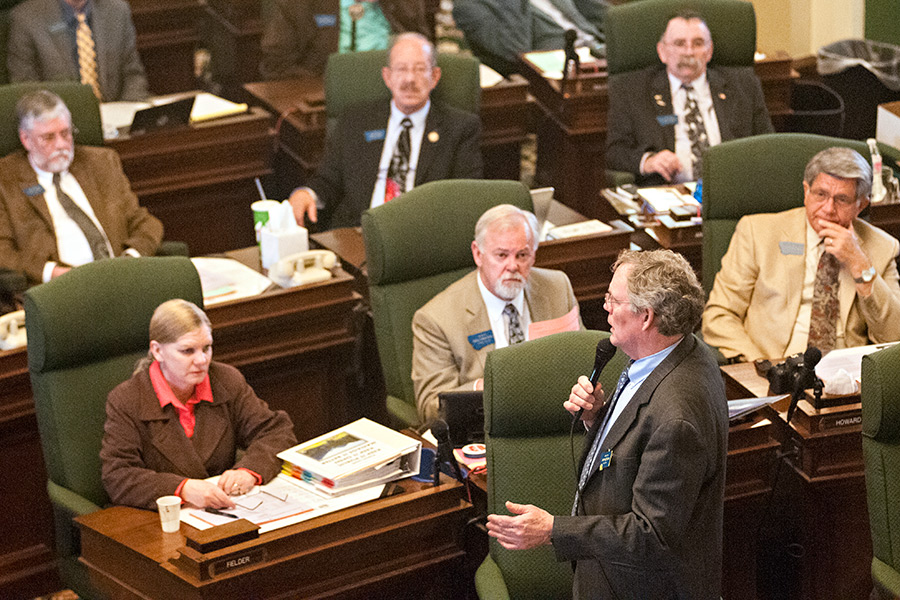Behind the Battle Over Public Land
Land managers, conservationists and sportsmen groups are pushing back against the notion of land transfers with increasing force
By Tristan Scott
On Jan. 30, a lively crowd of more than 1,000 public land advocates packed the Capitol rotunda floor, lining the balconies of the statehouse in Helena while chanting, “Keep public lands in public hands,” and waving signs denouncing the sale of “Our American Heritage.”
Conrad Anker, the famous mountaineer who has summited Mount Everest three times and who lives in Bozeman, raised his chin and literally howled at the high-domed ceiling, invoking the wild heritage of Montana’s outdoors and calling on attendees to protect public land while holding their lawmakers accountable.
“We do not inherit the earth from our ancestors; we borrow it from our children,” he said, paraphrasing Duwamish Chief Seattle.
Fly-fishing guide and Trout TV host Hilary Hutcheson, who grew up in Columbia Falls and is raising her daughters under the banner of Glacier National Park’s peak-studded boundary, said the quality of her family’s outdoor environment is critically linked to their livelihood.
“We’re not doing all we can as parents if we’re not fighting this threat to our children’s birthright,” she said. “I’m not forgetting our sons, but let me talk about our daughters. We need little girls growing up with the dirt of public lands under their nails because they will become the wild Montana women who go out and make history.”
Organizers estimate that the raucous rally drew twice the number of attendees who gathered during the 2015 legislative session, a testament to the growing intensity of the debate over federal land management and the groundswell of opposition to proposals that would relegate ownership of public lands to the states.
And yet, despite the overwhelming support for public land, the national debate over its management authority has been revived in earnest, with some observers calling it a reprise of the so-called Sagebrush Rebellion of the 1970s and 1980s that sought dramatic changes to federal land control.
Assuming control over lands now controlled by federal agencies has become a popular stance adopted by Montana’s conservative lawmakers, while emerging nationally as a GOP-driven platform plank that continues to gain leverage, particularly as flaws in federal management practices become more pronounced in the wake of devastating wildfire seasons, diminished timber harvests and economic harm.

But just as the effort to transfer ownership of public land gains momentum in the halls of Congress, efforts to protect broad swaths of federally managed parcels are gaining steam among a majority of voters across the Mountain West, who say they don’t want their public lands sold or transferred to states, according to recent public polling of seven western states.
The Colorado College State of the Rockies Project released its seventh consecutive Conservation in the West Poll on Jan. 31, reporting that wide majorities of voters of all stripes in every state except Utah oppose federal land transfers.
Among the findings, 58 percent of those polled said they opposed transferring control of federal public lands to states, while 68 percent said they prioritized protecting water, air and wildlife with opportunities for recreation on public land.
“As leadership changes hands in Washington, D.C., and Congress votes in new budget rules removing any monetary value from public lands, voters in the Mountain West are sending a clear statement that they do not want to see a dramatic change of course when it comes to national public lands,” said Walt Hecox, an economics professor emeritus at Colorado College and founder of the State of the Rockies Project.
That message echoed throughout the Rocky Mountains last week when, on Feb. 2, U.S. Rep. Jason Chaffetz, R-Utah, withdrew legislation that would have transferred 3 million acres of land from federal to state ownership, citing objections from constituents who complained that the move would limit access to public hunting and fishing grounds.
The Disposal of Excess Federal Lands Act, or H.R. 621, would have shifted federal holdings to state governments in Utah, Arizona, Colorado, Idaho, Montana, Nebraska, Nevada, New Mexico, Oregon, and Wyoming, and prompted an outcry among hunters and anglers’ groups.
The bill, which Chaffetz has also introduced in past congressional sessions, stood out as the cause du jour for the rally in Helena, as well as a separate event that drew similar attendance in Santa Fe, New Mexico.
Two days after the rallies, Chaffetz posted an Instagram photo of himself hunting with his dog, signaling his intent to withdraw the legislation. Referring to the now-defunct measure, he wrote that “groups I support and care about fear it sends the wrong message … I hear you and HR 621 dies tomorrow #keepitpublic.”
>>>>Read More: Key Players on the Landscape
Land Tawney, president of Backcountry Hunters and Anglers, said he was encouraged by the Congressman’s about-face, and urged Montanans to continue speaking out in support of public lands, which he said are increasingly coming under threat of attack.
“His fellow lawmakers should take note of the ire and rapid response by hunters and anglers,” Tawney said. “We aren’t going away.”
But proponents of the land transfer idea say Montana residents are better poised to manage their lands than Washington bureaucrats, and that federal agencies have been struggling for decades to effectively manage lands against litigation and plodding analysis procedures.
Montana State Sen. Jennifer Fielder, R-Thompson Falls, has emerged in recent years as one of the most vocal advocates for federal land transfers in the country, and last year took over as CEO of the American Lands Council, the organization leading the charge for western states to take over federal lands.
Elected to the Montana Senate in 2012, Fielder quickly made herself known as a public-lands takeover advocate, successfully introducing a resolution authorizing a legislative working group, which she chaired, to carry out a survey of federal land management in the state, issuing a final report that critics said promoted transferring federal lands. In 2015, she sponsored a bill to create a public-lands task force, which passed through the Montana Legislature before Democratic Gov. Steve Bullock vetoed it.
This session, Fielder has requested two resolutions on land transfers — one to study the transfer, or “conveyance,” of federal lands to the state, and another to request the wholesale transfer of federal lands to the state. Because resolutions do not require the governor’s signature, critics worry that the resolution could pass with a simple legislative majority and create the appearance that Montana is a “willing state” eager to take over national public lands within its borders.
At the federal level, the land-transfer effort was on prominent display last month when the U.S. House of Representatives, including Montana Republican Congressman Ryan Zinke, the Trump Administration’s pick for the next Interior Secretary, passed a rules package that contained provisions that make it easier for Congress to transfer lands.
“We must recognize that, taken collectively, these actions form a coordinated and dangerous strategy to seize our public lands,” said Kayje Booker, state policy director for the Montana Wilderness Association. “Under a new administration with a relatively unknown and untested approach to public lands, these efforts could very well succeed if we allow them to move forward unchallenged.”

For Fielder, the rules change was a welcome victory.
“The 115th Congress is off to a great start with this simple change in its procedural rules to facilitate bringing public land management closer to home,” Fielder wrote on the ALC website. “It is a refreshing sign of hope for the vast number of Americans who are concerned and outraged about the flagrant disregard by the U.S. federal government when it comes to how federally controlled public lands have been mismanaged on their watch. The balance has tipped too far towards distant, unaccountable bureaucracy and the results have been devastating to our rivers, prairies, forests, and wildlife.”
It came as a disappointment, then, when four days later, while attending Zinke’s confirmation hearing before the Senate Energy and Natural Resources Committee in Washington, D.C., Fielder listened to Montana’s lone congressman take questions for four hours, including numerous inquiries about his stance on public lands.
“I am absolutely against transfer or sale of public lands,” Zinke said in response to a question from Sen. Maria Cantwell, a Democrat from Washington, during his recent committee hearings. “I can’t be more clear.”
Afterward, Fielder tweeted that, “after gently explaining TPL (the Transfer of Public Lands movement) to Congressman/Seal Commander/soon to be Sec of Interior Ryan Zinke, he needed more of a nudge.”
Back in Montana, state and federal agencies, land managers and timber industry officials, including the Montana Wood Products Association, are unequivocal in their opposition to land transfers, due in large part because they say it is logistically and financially unfeasible.
The federal government owns more land west of the Rocky Mountains than in any other region, ranging from 30 percent in Montana, to 35 percent in New Mexico and 81 percent in Nevada.
In Northwest Montana alone, 2.3 million acres of national forest fall under the management of the Flathead National Forest, with an additional 2.2 million acres under federal jurisdiction in the Kootenai National Forest. Statewide, nearly 30 million acres of land are managed by federal agencies such as the Forest Service and Bureau of Land Management.
In Montana, the Department of Natural Resources and Conservation manages 599,000 forest acres, compared to the Forest Service’s 17.1 million acres, with state timber sales generating an average of $8.9 million per year for the former, and an average of $1.6 million a year for the latter.
Although the revenue disparity between Montana’s state and federal land agencies is significant, their management policies are not analogous.
The DNRC has a constitutional mission to maximize revenues from school trust lands — a singular charge far less complex than the Forest Service’s “sustainable multiple-use management concept” to meet the diverse needs of people while protecting the resources and wildlife, and less prone to litigation.
According to DNRC Director John Tubbs, the so-called “analysis paralysis” that bogs down the Forest Service would not disappear if the state took over management.
“None of the challenges that the federal agencies face today would go away just because you put the state of Montana’s name on it,” he said.